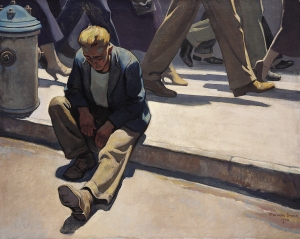During my studies at Brigham Young University, I often gravitated to the new Museum of Art building during the late afternoons. The high ceilings and well-lighted space stood in stark contrast to the thick, cold walls of the engineering building. The museum and its beautiful paintings—representations of what made other people tick—recharged me and clarified my purpose better than almost any other place or thing. One painting, compassionately done by a man concerned about the harsh working conditions during the Great Depression, became one of my favorites.
Forgotten Man (Maynard Dixon, 1934) depicts a lonely man who appears to be down on his luck, maybe a transient, despondently sitting on a curb with the fast-paced rush of the world passing behind him. To me, it represents all of us who, at one time or another, struggle to find purpose in what we do, or, perhaps, to feel needed in a world with ever-changing job-skill requirements.
Courtesy Brigham Young University Museum of Art
I used to look at this painting and think to myself, “If I were replaced by another working cog or simply displaced, would the world even notice or care?” Fortunately, I could quickly take comfort in knowing that while the world might not notice, my family certainly would, and that kept me pushing forward. It helped me to focus my actions at a local level, along the lines of the famous couplet, “Think globally; act locally.”
Over the years it has reminded me, at a professional level, of the limitations that architects, planners and engineers have to solve societal problems. While we can change and mold physical appearances and improve the operations of the world we live in—the form and function—we cannot shape human behavior. It would be presumptive and arrogant to claim that even great design can yield lasting change in people’s behavior. This brings to mind the many failed attempts at master planning and social engineering of the past.
People, as one former U.S. secretary of agriculture observed, are changed from the inside out, not the outside in. The slums need to be taken out of the people before the people can be taken out of the slums (see Born of God, Ezra Taft Benson).
As I look at this painting today, more than half of my life having passed since I first saw it, I look at it with a different perspective. As a civil engineer, I see a street, a curb and gutter, a sidewalk and hydrant, all physical features that I am now intimately familiar with and that I could draw with perfect detail if asked. As a human being, though, how well do I know the man? And where should my concern be, with concrete and steel, or with him?




Clay, Love your posts. You are a beautifully descriptive writer and the passion you have for whatever you speak is clearly evident. You are young, but perceptive and wise. Thank you for your poignant thoughts.
This was also one of my favorite paintings at the MOA. thanks for the post.
Russ Lay
Thanks for reading, Russ. Hope things are going well for you.
I’m surprised to think that you feel designers have had a perceived responsibility to change human nature. It’s true that a certain architecture is celebrated for its “paradigm shifts” or “societal juxtapositions” but those forms rarely turn into function.
In my design-build experience, the best designers don’t look to change society’s behavior but rather use design to improve the function of society’s innate behavior.
The best metaphor would be a civil engineer that doesn’t change the way water wants to flow, rather he first understands how it wants to flow across a site, then modifies the site so that water flows naturally without negative impacts to the new use/users of the site.
The Forgotten Man is one of my favorite MOA pieces too.
Thanks for your comments, Nate. I must not have been clear enough. Quoting the fourth paragraph, “We [architects, designers, engineers] cannot shape human behavior. It would be presumptive and arrogant to claim that even great design can yield lasting change in people’s behavior. This brings to mind the many failed attempts at master planning and social engineering of the past.” The link to Secretary Benson’s talk describes the one thing that can change human nature.
I like your idea about engineers working with rather than against nature.